Places of Myth
37 Thebes

Oedipus and the Sphinx, red-figure kylix, ca. 460 BCE (Museo Gregoriano Estrusco, Vatican City)
Foundation
Mythological
In mythology, Thebes was founded by the Phoenician prince Cadmus. He arrived in Greece while searching for his sister, Europa, who had been kidnapped by Zeus and taken to Crete. The royal family of Thebes was then descended from Cadmus and Harmonia, the daughter of the deities Aphrodite and Ares. The family was famously plagued by curses, murders, and vendettas. The city was known for its fortified citadel, the Cadmea, and its walls with seven gates built with magic by the demigod Amphion.
Historical
The archaeological record shows that Thebes, situated in Boeotia in central Greece, has been inhabited since the 3rd millennium BCE. The city rose to prominence during the Bronze Age and became a powerful Mycenaean palatial centre. The Cadmea hill, which hosted the main religious and political buildings, was walled and fortified during this period. Thebes was affected by the Bronze Age Collapse, but recovered and established itself as one of the most prominent city-states of Greece during the Archaic and Classical periods. After being destroyed by Alexander the Great in 335 BCE, the city was rebuilt and repopulated. The continuous occupation of the site makes it difficult to have a clear picture of the size and extension of the ancient city. The majority of the visible remains date from the Classical and Hellenistic periods; however, part of the Mycenaean palace is still visible in the city centre.
Mythology
Sections & Primary Sources
The House of Cadmus
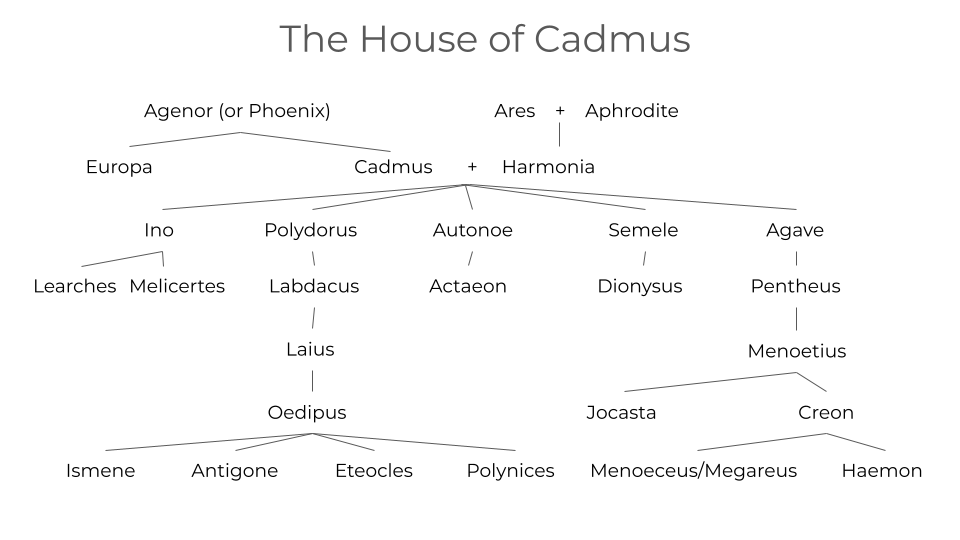
Pseudo-Apollodorus, Bibliotheca, Book 3 (trans. J. G. Frazer, adapted by L. Zhang)
Greek mythography, 2nd century BCE
[content warning for the following source: graphic descriptions of death, self harm and suicide]
[3.4.1] When Telephassa died, Cadmus buried her, and after being hospitably received by the Thracians he came to Delphi to inquire about Europa. The god told him not to worry about Europa, but to be guided by a cow, and to found a city wherever she should fall down for weariness. After receiving such an oracle he journeyed through Phocis; then falling in with a cow among the herds of Pelagon, he followed it behind. And after traversing Boeotia, it sank down where is now the city of Thebes. Wishing to sacrifice the cow to Athena, he sent some of his companions to draw water from the spring of Ares. But a dragon, which some said was the offspring of Ares, guarded the spring and destroyed most of those that were sent. In his indignation Cadmus killed the dragon, and by the advice of Athena sowed its teeth. When they were sown there rose from the ground armed men whom they called Sparti. These slew each other, some in a chance brawl, and some in ignorance. But Pherecydes says that when Cadmus saw armed men growing up out of the ground, he flung stones at them, and they, supposing that they were being pelted by each other, came to blows. However, five of them survived, Echion, Udaeus, Chthonius, Hyperenor, and Pelorus.
[3.4.2] But Cadmus, to atone for the slaughter, served Ares for an eternal year; and the year was then equivalent to eight years of our calendar.
After his servitude, Athena procured for him the kingdom, and Zeus gave to him Harmonia as wife, daughter of Aphrodite and Ares. And all the gods left the sky, and feasting in the Cadmea celebrated the marriage with hymns. Cadmus gave her a robe and the necklace wrought by Hephaestus, which some say was given to Cadmus by Hephaestus, but Pherecydes[1] says that it was given by Europa, who had received it from Zeus. And to Cadmus were born daughters, Autonoe, Ino, Semele, Agave, and a son Polydorus. Ino was married to Athamas, Autonoe to Aristaeus, and Agave to Echion.
[3.4.3] But Zeus loved Semele and slept with her, unknown to Hera. Now Zeus had agreed to do for her whatever she asked, and deceived by Hera she asked him to come to her as he came when he was wooing Hera. Unable to refuse, Zeus came to her bridal chamber in a chariot, with lightnings and thunderings, and launched a thunderbolt. But Semele died of fright, and Zeus, snatching the sixth-month abortive child from the fire, sewed it into his thigh. Upon the death of Semele, the other daughters of Cadmus spread a report that Semele had slept with a mortal man, and had falsely accused Zeus, and that therefore she had been blasted by thunder. But, at the proper time, Zeus undid the stitches and gave birth to Dionysus, and entrusted him to Hermes. And he conveyed him to Ino and Athamas, and persuaded them to raise him as a girl.[2] But Hera indignantly drove them mad, and Athamas hunted his elder son Learchus as a deer and killed him, and Ino threw Melicertes into a boiling cauldron, then carrying it with the dead child she sprang into the deep. And she herself is called Leucothea, and the boy is called Palaemon, such being the names they get from sailors; for they assist storm-tossed mariners. And the Isthmian games were instituted by Sisyphus in honour of Melicertes. But Zeus escaped the wrath of Hera by turning Dionysus into a goat kid, and Hermes took him and brought him to the nymphs who dwelt at Nysa in Asia, whom Zeus afterwards changed into stars and named them the Hyades.
[3.4.4] Autonoe and Aristaeus had a son Actaeon, who was raised by Chiron to be a hunter and then afterwards was devoured on Cithaeron by his own dogs. He perished in that way, according to Acusilaus,[3] because Zeus was angry at him for wooing Semele; but according to the more general opinion, it was because he saw Artemis bathing. And they say that the goddess at once transformed him into a deer, and drove mad the fifty dogs in his pack, which devoured him unknowingly. Actaeon being gone, the dogs sought their master howling lamentably, and in the search they came to the cave of Chiron, who fashioned an image of Actaeon, which soothed their grief.
[The names of Actaeon‘s dogs from the ((lacuna))[4] . . . So now surrounding his fair body, as if it were that of a beast, the strong dogs tore it. Near Arcena first ((lacuna)) . . . after her a mighty brood, Lynceus and Balius goodly-footed, and Amarynthus. — And these he listed continuously by name. And then Actaeon perished at the instigation of Zeus. For the first that drank their master’s black blood were Spartus and Omargus and Bores, the swift on the track. These first fed on Actaeon and lapped his blood. And after them others rushed on him eagerly ((lacuna)) . . . to be a remedy for grievous pains to men.]
[ . . . ]
[3.5.2] Having traversed Thrace and the whole of India and set up pillars there, Dionysus arrived to Thebes, and forced the women to abandon their houses and rave in Bacchic frenzy on Cithaeron. But Pentheus, whom Agave bore to Echion, had succeeded Cadmus in the kingdom, and he attempted to put a stop to these proceedings. And coming to Cithaeron to spy on the Bacchanals [ Bacchantes ], he was torn limb from limb by his mother Agave in a fit of madness; for she thought he was a wild beast.[5] And having shown the Thebans that he was a god, Dionysus came to Argos, and there again, because they did not honour him, he drove the women mad, and they on the mountains devoured the flesh of the infants whom they carried at their breasts.
[3.5.3] And wishing to be ferried across from Icaria to Naxos he hired a pirate ship of Tyrrhenians. But when they had put him on board, they sailed past Naxos and made for Asia, intending to sell him. Howbeit, he turned the mast and oars into snakes, and filled the vessel with ivy and the sound of flutes. And the pirates went mad, and leaped into the sea, and were turned into dolphins.[6] Thus men perceived that he was a god and honoured him; and having brought up his mother from Hades and named her Thyone, he ascended up with her to heaven.
[3.5.4] But Cadmus and Harmonia left Thebes and went to the Encheleans. As the Encheleans were being attacked by the Illyrians, the god [ Apollo ] declared by an oracle that they would get the better of the Illyrians if they had Cadmus and Harmonia as their leaders. They believed him, and made them their leaders against the Illyrians, and got the better of them. And Cadmus reigned over the Illyrians, and a son Illyrius was born to him. But afterwards he was, along with Harmonia, turned into a serpent and sent away by Zeus to the Elysian Fields.
[3.5.5] Polydorus, having become king of Thebes, married Nycteis, daughter of Nycteus, son of Chthonius, and had Labdacus, who perished after Pentheus because he agreed with him. But Labdacus having left a year-old son, Laius, the government was usurped by Lycus, brother of Nycteus, so long as Laius was a child. Lycus and Nycteus had fled [from Euboea] because they had killed Phlegyas, son of Ares and Dotis the Boeotian, and they took up their abode at Hyria, and having come to Thebes since then, they were made citizens through their friendship with Pentheus. So after being chosen commander-in-chief by the Thebans, Lycus compassed the supreme power and reigned for twenty years, but was murdered by Zethus and Amphion for the following reason. Antiope was a daughter of Nycteus, and Zeus had intercourse with her. When she was with child, and her father threatened her, she ran away to Epopeus at Sicyon and was married to him. In a state of hopelessness, Nycteus killed himself, after charging Lycus with the task to punish Epopeus and Antiope. Lycus marched against Sicyon, subdued it, slew Epopeus, and led Antiope away captive. On the way she gave birth to two sons at Eleurethae in Boeotia. The infants were exposed,[7] but a cowherd found and reared them, and he called the one Zethus and the other Amphion. Now Zethus paid attention to cattle-breeding, but Amphion practiced music, for Hermes had given him a lyre. But Lycus and his wife Dirce imprisoned Antiope and treated her poorly. However, one day her bonds fell off themselves, and unknown to her keepers she came to her sons cottage, begging that they would take her in. They recognized their mother and slew Lycus, but they tied Dirce to a bull, and flung her dead body into the spring that is called Dirce after her. And having succeeded to the sovereignty they fortified the city, the stones moving with Amphion‘s music; and they expelled Laius. He resided in Peloponnese, being hospitably received by Pelops; and while he taught Chrysippus, the son of Pelops, to drive a chariot, he conceived a passion for the lad and kidnapped him.
[3.5.6] Zethus married Thebe, after whom the city of Thebes is named; and Amphion married Niobe, daughter of Tantalus, who bore seven sons, Sipylus, Eupinytus, Ismenus, Damasichthon, Agenor, Phaedimus, Tantalus, and the same number of daughters, Ethodaia (or, as some say, Neaera), Cleodoxa, Astyoche, Phthia, Pelopia, Astycratia, and Ogygia, But Hesiod says that they had ten sons and ten daughters; Herodorus that they had two male children and three female; and Homer that they had six sons and six daughters. Being blessed with children, Niobe said that she was more blessed with children than Leto. Stung by the taunt, Leto incited Artemis and Apollo against them, and Artemis shot down the females in the house, and Apollo killed all the males together as they were hunting on Cithaeron. Of the males Amphion alone was saved, and of the females Chloris the elder, whom Neleus married. But according to Telesilla there were saved Amyclas and Meliboea, and Amphion also was shot by them. But Niobe herself left Thebes and went to her father Tantalus at Sipylus, and there, on praying to Zeus, she was transformed into a stone, and tears flow night and day from the stone.[8]
[3.5.7] After Amphion‘s death, Laius succeeded to the kingdom. And he married a daughter of Menoeceus; some say that she was Jocasta, and some that she was Epicasta. The oracle had warned him not to have a son, for that son would kill his father; nevertheless, drunk with wine, he had intercourse with his wife. And when the infant was born he pierced the child’s ankles with brooches and gave it to a herdsman to expose. But the herdsman exposed it on Cithaeron; and the cowherds of Polybus, king of Corinth, found the infant and brought it to his wife Periboea. She adopted him and raised him as her own, and after she had healed his ankles she called him Oedipus, giving him that name on account of his swollen feet.[9]When the boy grew up and excelled among his peers in strength, they spitefully ridiculed him for being a substitute. He asked Periboea, but could learn nothing; so he went to Delphi and inquired about his true parents. The god told him not to go to his native land, because he would murder his father and lie with his mother. On hearing that, and believing himself to be the son of those who raised him, he left Corinth, and riding in a chariot through Phocis he met Laius who was driving in a chariot in a certain narrow road.[10] And when Polyphontes, the herald of Laius, ordered him to make way and killed one of his horses because he disobeyed and delayed them, Oedipus killed both Polyphontes and Laius out of anger before arriving in Thebes.
[3.5.8] Laius was buried by Damasistratus, king of Plataea, and Creon, son of Menoeceus, succeeded to the kingdom. In his reign a heavy calamity befell Thebes. For Hera sent the Sphinx, whose mother was Echidna and her father Typhon; and she had the face of a woman, the breast and feet and tail of a lion, and the wings of a bird. And having learned a riddle from the Muses, she sat on Mount Phicium, and posited it to the Thebans. And the riddle was this: — What is that which has one voice and yet becomes four-footed and two-footed and three-footed? Now the Thebans were in possession of an oracle which declared that they should be rid of the Sphinx whenever they had solved her riddle; so they often met and discussed the answer, and when they could not find it the Sphinx used to snatch away one of them as her meal. When many had perished, and last of all Creon‘s son Haemon, Creon made proclamation that to him who should solve the riddle he would give both the kingdom and the wife of Laius. On hearing that, Oedipus found the solution, declaring that the riddle of the Sphinx referred to man; for as a babe he is four-footed, going on four limbs, as an adult he is two-footed, and as an old man he gets besides a third support in a staff. So the Sphinx threw herself from the citadel, and Oedipus both succeeded to the kingdom and unwittingly married his mother, and begat sons by her, Polynices and Eteocles, and daughters, Ismene and Antigone. But some say the children were borne to him by Eurygania, daughter of Hyperphas.
[3.5.9] When the secret afterwards came to light, Jocasta hanged herself in a noose, and Oedipus was driven from Thebes, after he had blinded himself and cursed his sons, who saw him cast out of the city without lifting a hand to help him. And having gone with Antigone to Colonus in Attica, the precinct of the Eumenides, he sat down there as a suppliant, was kindly received by Theseus, and died not long afterwards.
[3.6.1] Now Eteocles and Polynices made a contract with each other concerning the kingdom and resolved that each should rule alternately for a year at a time. Some say that Polynices was the first to rule, and that after a year he handed over the kingdom to Eteocles; but some say that Eteocles was the first to rule, and would not hand over the kingdom. So, being banished from Thebes, Polynices came to Argos, taking with him the necklace and the robe [of Harmonia]. The king of Argos was Adrastus, son of Talaus; and Polynices went up to his palace by night and engaged in a fight with Tydeus, son of Oeneus, who had fled from Calydon. At the sudden outcry Adrastus appeared and parted them, and remembering the words of a certain seer who told him to yoke his daughters in marriage to a boar and a lion,[11] he accepted them both as bridegrooms, because they had on their shields, the one the forepart of a boar, and the other the forepart of a lion. And Tydeus married Deipyle, and Polynices married Argia; and Adrastus promised that he would restore them both to their native lands. And first he was eager to march against Thebes, and he mustered the chiefs.
[3.6.2] But Amphiaraus, son of Oicles, being a seer and foreseeing that all who joined in the expedition except Adrastus were destined to perish, refused to go and discouraged the rest. However, Polynices went to Iphis, son of Alector, and begged to know how Amphiaraus could be compelled to go to the war. He answered that it could be done if Eriphyle got the necklace [of Harmonia]. Now Amphiaraus had forbidden Eriphyle to accept gifts from Polynices; but Polynices gave her the necklace and begged her to persuade Amphiaraus to go to the war; for the decision lay with her, because once, when a difference arose between him and Adrastus, he reconciled with him and sworn to let Eriphyle decide any future dispute he might have with Adrastus. Accordingly, when war was to be made on Thebes, and the measure was advocated by Adrastus and opposed by Amphiaraus, Eriphyle accepted the necklace and persuaded him to march with Adrastus. Thus forced to go to the war, Amphiaraus laid his commands on his sons, that, when they were grown up, they should slay their mother and march against Thebes.
[3.6.3] Having mustered an army with seven leaders, Adrastus hastened to wage war on Thebes. The leaders were these: Adrastus, son of Talaus; Amphiaraus, son of Oicles; Capaneus, son of Hipponous; Hippomedon, son of Aristomachus, but some say of Talaus. These came from Argos; but Polynices, son of Oedipus, came from Thebes; Tydeus, son of Oeneus, was an Aetolian; Parthenopaeus, son of Melanion, was an Arcadian. Some, however, do not agree Tydeus and Polynices among them, but include Eteoclus, son of Iphis, and Mecisteus in the list of the seven.[12]
[3.6.4] Having come to Nemea, of which Lycurgus was king, they asked for water; and Hypsipyle showed them the way to a spring, leaving behind an infant boy Opheltes, whom she nursed, a child of Eurydice and Lycurgus. For the Lemnian women, afterwards learning that Thoas had been saved alive, put him to death and sold Hypsipyle into slavery; wherefore she served in the house of Lycurgus as a purchased bondwoman. But while she showed the spring, the abandoned boy was killed by a serpent. When Adrastus and his party appeared on the scene, they slew the serpent and buried the boy; but Amphiaraus told them that the sign foreboded the future, and they called the boy Archemorus.[13] They celebrated the Nemean games in his honour; and Adrastus won the horse race, Eteoclus the footrace, Tydeus the boxing match, Amphiaraus the leaping and discus match, Laodocus the javelin-throwing match, Polynices the wrestling match, and Parthenopaeus the archery match.
[3.6.5] When they came to Cithaeron, they sent Tydeus to tell Eteocles in advance that he must cede the kingdom to Polynices, as they had agreed among themselves. As Eteocles paid no heed to the message, Tydeus, by way of testing the Thebans, challenged them to single combat and was victorious in every encounter; and though the Thebans set fifty armed men to lie in wait for him as he went away, he slew them all but Maeon, and then came back to the camp.
[3.6.6] Having armed themselves, the Argives approached the walls; and as there were seven gates, Adrastus was stationed at the Homoloidian gate, Capaneus at the Ogygian, Amphiaraus at the Proetidian, Hippomedon at the Oncaidian, Polynices at the Hypsistan, Parthenopaeus at the Electran, and Tydeus at the Crenidian. Eteocles on his side armed the Thebans, and having appointed leaders to match those of the enemy in number, he put the battle in array, and resorted to divination to learn how they might overcome the foe.
[3.6.7] Now there was among the Thebans a soothsayer, Teiresias, son of Everes and a nymph Chariclo, of the family of Udaeus, the Spartan [ one of the Spartoi ] and he had lost the sight of his eyes. Different stories are told about his blindness and his power of soothsaying. For some say that he was blinded by the gods because he revealed their secrets to men. But Pherecydes says that he was blinded by Athena[14]; for Chariclo was dear to Athena ((lacuna)). . . and Teiresias saw the goddess stark naked, and she covered his eyes with her hands, and so rendered him sightless. And when Chariclo asked her to restore his sight, she could not do so, but by cleansing his ears she caused him to understand every note of birds; and she gave him a staff of cornel-wood, with which he walked like those who see. But Hesiod says that he saw snakes copulating on Cyllene, and that having wounded them he was turned from a man into a woman, but that on observing the same snakes copulating again, he became a man. Hence, when Hera and Zeus disputed whether the pleasures of love are felt more by women or by men, they referred to him for a decision. He said that if the pleasures of love be reckoned at ten, men enjoy one and women nine. For this reason Hera blinded him, but Zeus bestowed on him the art of soothsaying. The saying of Teiresias to Zeus and Hera, “Of ten parts a man enjoys one only; but a woman enjoys the full ten parts in her heart.” He also lived to a great age.
So when the Thebans sought counsel of him, he said that they should be victorious if Menoeceus, son of Creon, would offer himself freely as a sacrifice to Ares. On hearing that, Menoeceus, son of Creon, slew himself before the gates. But a battle having taken place, the Cadmeans were chased in a crowd as far as the walls, and Capaneus, seizing a ladder, was climbing up it to the walls, when Zeus smote him with a thunderbolt.
[3.6.8] At the sight of the smiting, the Argives turned to flee. And as many fell, Eteocles and Polynices, by the resolution of both armies, fought a single combat for the kingdom, and slew each other. In another fierce battle the sons of Astacus did brave deeds; for Ismarus slew Hippomedon, Leades slew Eteoclus, and Amphidicus slew Parthenopaeus. But Euripides says that Parthenopaeus was slain by Periclymenus, son of Poseidon. And Melanippus, the remaining one of the sons of Astacus, wounded Tydeus in the belly. As he lay half dead, Athena brought a medicine which she had begged of Zeus, and by which she intended to make him immortal. But Amphiaraus hated Tydeus for thwarting him by persuading the Argives to march to Thebes; so when he perceived the intention of the goddess he cut off the head of Melanippus and gave it to Tydeus, who, wounded though he was, had killed him. And Tydeus split open the head and gulped up the brains. But when Athena saw that, in disgust she was enraged and withheld the intended benefit. Amphiaraus fled beside the river Ismenus, and before Periclymenus could wound him in the back, Zeus cleft the earth by throwing a thunderbolt, and Amphiaraus vanished with his chariot and his charioteer Baton, or, as some say, Elato; and Zeus made him immortal. Adrastus alone was saved by his horse Arion. That horse Poseidon begot by Demeter, when in the likeness of a Fury she consorted with him.
[3.7.1] Having succeeded to the kingdom of Thebes, Creon cast out the Argive dead unburied, issued a proclamation that none should bury them, and set watchmen. But Antigone, one of the daughters of Oedipus, stole the body of Polynices, and secretly buried it, and having been detected by Creon himself, she was interred alive in the grave. Adrastus fled to Athens and took refuge at the altar of Mercy, and laying on it the suppliant’s bough[15] he prayed that they would bury the dead. And the Athenians marched with Theseus, captured Thebes, and gave the dead to their kinsfolk to bury. And when the pyre of Capaneus was burning, his wife Evadne, the daughter of Iphis, threw herself on the pyre, and was burned with him.
[3.7.2] Ten years afterwards the sons of the fallen, called the Epigoni, purposed to march against Thebes to avenge the death of their fathers; and when they consulted the oracle, the god [ Apollo ] predicted victory under the leadership of Alcmaeon. So Alcmaeon joined the expedition, though he did not want to lead the army until he had punished his mother; for Eriphyle had received the robe from Thersander, son of Polynices, and had persuaded her sons also to go to the war. Having chosen Alcmaeon as their leader, they made war on Thebes. The men who took part in the expedition were these: Alcmaeon and Amphilochus, sons of Amphiaraus; Aegialeus, son of Adrastus; Diomedes, son of Tydeus; Promachus, son of Parthenopaeus; Sthenelus, son of Capaneus; Thersander, son of Polynices; and Euryalus, son of Mecisteus.
[3.7.3] They first laid waste the surrounding villages; then, when the Thebans advanced against them, led by Laodamas, son of Eteocles, they fought bravely, and though Laodamas killed Aegialeus, he was himself killed by Alcmaeon, and after his death the Thebans fled in a body within the walls. But as Teiresias told them to send a herald to treat with the Argives, and themselves to take to flight, they did send a herald to the enemy, and, mounting their children and women on the wagons, themselves fled from the city. When they had come by night to the spring called Tilphussa, Teiresias drank of it and died. After travelling far the Thebans built the city of Hestiaea and took up their abode there.
[3.7.4] But the Argives, on learning afterwards the flight of the Thebans, entered the city and collected the booty, and pulled down the walls. But they sent a portion of the booty to Apollo at Delphi and with it Manto, daughter of Teiresias; for they had vowed that, if they took Thebes, they would dedicate to him the fairest of the spoils.
[3.7.5] After the capture of Thebes, when Alcmaeon learned that his mother Eriphyle had been bribed to his undoing along with his father’s, he was more angry than ever, and in accordance with an oracle given to him by Apollo he killed his mother. Some say that he killed her in conjunction with his brother Amphilochus, others that he did it alone. But Alcmaeon was visited by the Fury of his mother’s murder, and going mad he first sought help from his paternal grandfather, Oicles, in Arcadia, and then to Phegeus at Psophis.[16] And having been purified[17] by him he married Arsinoe, daughter of Phegeus, and gave her the necklace and the robe. But afterwards the ground became barren on his account, and the god told him in an oracle to depart to Achelous and to stand another trial on the river bank. At first he went to Oeneus at Calydon and was hosted by him; then he went to the Thesprotians, but was driven away from the country; and finally he went to the springs of Achelous, and was purified by him, and received Callirrhoe, his daughter, to wife. Moreover he colonized the land which the Achelous had formed by its silt, and he took up his abode there. But afterwards Callirrhoe coveted the necklace and robe, and said she would not live with him if she did not get them. So away Alcmaeon went to Psophis and told Phegeus how it had been predicted that he should be rid of his madness when he had brought the necklace and the robe to Delphi and dedicated them. Phegeus believed him and gave them to him. But a servant having let out that he was taking the things to Callirrhoe, Phegeus commanded his sons, and they lay in wait and killed him. When Arsinoe reproached them, the sons of Phegeus shoved her into a chest and carried her to Tegea and gave her as a slave to Agapenor, falsely accusing her of Alcmaeon‘s murder.
[3.7.6] Being informed of Alcmaeon‘s untimely end and courted by Zeus, Callirrhoe requested that the sons she had by Alcmaeon might be full grown in order to avenge their father’s murder. And being suddenly full-grown, the sons went forth to right their father’s wrong. Now Pronous and Agenor, the sons of Phegeus, carrying the necklace and robe to Delphi to dedicate them, turned in at the house of Agapenor at the same time as Amphoterus and Acarnan, the sons of Alcmaeon. The sons of Alcmaeon killed their father’s murderers, and going to Psophis and entering the palace they slew both Phegeus and his wife. They were pursued as far as Tegea, but saved by the intervention of the Tegeans and some Argives, and the Psophidians took to flight.
[3.7.7] Having told their mother these things, they went to Delphi and dedicated the necklace and robe according to the injunction of Achelous. Then they journeyed to Epirus, collected settlers, and colonized Acarnania.
But Euripides says that in the time of his madness Alcmaeon had two children, Amphilochus and a daughter Tisiphone, by Manto, daughter of Teiresias and that he brought the babes to Corinth and gave them to Creon, king of Corinth, to bring up; and that on account of her extraordinary beauty Tisiphone was sold as a slave by Creon‘s spouse, who feared that Creon might make her his wedded wife. But Alcmaeon bought her and kept her as a handmaid, not knowing that she was his daughter, and coming to Corinth to get back his children he recovered his son also. And Amphilochus colonized Amphilochian Argos in obedience to oracles of Apollo.
Taken from: https://www.theoi.com/Text/Apollodorus3.html#4
The Theban Cycle
[content warning for the following source: self harm, suicide]
The Theban Cycle is a collection of lost four epic-style poetry within the Epic Cycle. It takes place before the Trojan War and it tells the mythological history of the founding family of the city of Thebes. The epics of the Theban Cycle are as follows: the Oedipodea, the Thebaid, the Epigoni, and the Alcmeonis. While these poems are lost, the content of the poems can be pieced together from fragments and mentions from other ancient authors.
For further discussion of the Epic Cycle, see chapter 29.
The Oedipodea tells the story of Oedipus and the Sphinx. Pausanias cites this poem to claim that Oedipus never has any children in his marriage with his mother, Jocasta (Description of Greece 9.5.10-11). Another source on the tragedy of Oedipus and his children survives in the trilogy of plays by the Athenian playwright, Sophocles: Oedipus Rex, Oedipus at Colonus, and Antigone. In Oedipus Rex, Oedipus is determined to find who murdered the previous king, Laius, in order to end a plague upon the city. When it is revealed that it was himself who killed his father and thus he had married and had children with his own mother, Jocasta, his queen, Jocasta hangs herself and Oepidus blinds himself. Oedipus at Colonus details Oedipus’ exile to Colonus, near Athens, with his daughters, Ismene and Antigone. He curses his sons for not being able to protect him well from Creon, who plans to kill him. He receives citizenship and protection in Athens, where he ultimately dies.
You can read the entirety of Oedipus Rex here and Oedipus at Colonus in English here.
The Thebaid describes the succession wars between the two sons of Oedipus, Polynices and Eteocles after his death. The events are famously retold by Athenian playwright, Aeschylus, in his tragic play, Seven Against Thebes. This play concerns the siege against the city led by Polynices and his Argive allies captained by the eponymous Seven and Eteocles sending out Theban champions to duel against the Seven. Ultimately, the Thebans drove away their enemies but both brothers die fighting each other.
You can read the entirety of Aeschylus’ Seven Against Thebes in English here.
Sophocles’ third Theban play, Antigone, details the events after the brothers die. It tells how their sister, Antigone, gives Polynices a proper burial against the now king Creon’s orders. The play ends in the death of Antigone, Haemon (Creon’s living son), and Eurydice (Creon’s wife).
You can read the entirety of Antigone in English here.
The Epigoni tells the tale of how the sons (the Epigoni) of the Seven caused the ultimate downfall of Thebes in a second war ten years after the first to take revenge for their fallen fathers. The Alcmeonis is the final of the Theban Cycle and is about Alcmaeon, one of the Epigoni, who kills his mother to avenge the death of his father. This story bears some similarities to the myth of Orestes and Clytemnestra (see chapter 11 and chapter 30).
The Thebes of Athenian playwrights often served as the flawed foil of Athens. The Thebans were enemies of Athens because they sided with the Persians during the Persian Wars, and the agenda of playwrights to win contests in the City Dionysia festival and gain popularity in Athens by villainizing Thebes should be kept in mind when reading these sources.
For further discussion of theatre culture in Athens, see chapter 43.
Art and Symbolism
[content warning for the following section: graphic depiction of death]
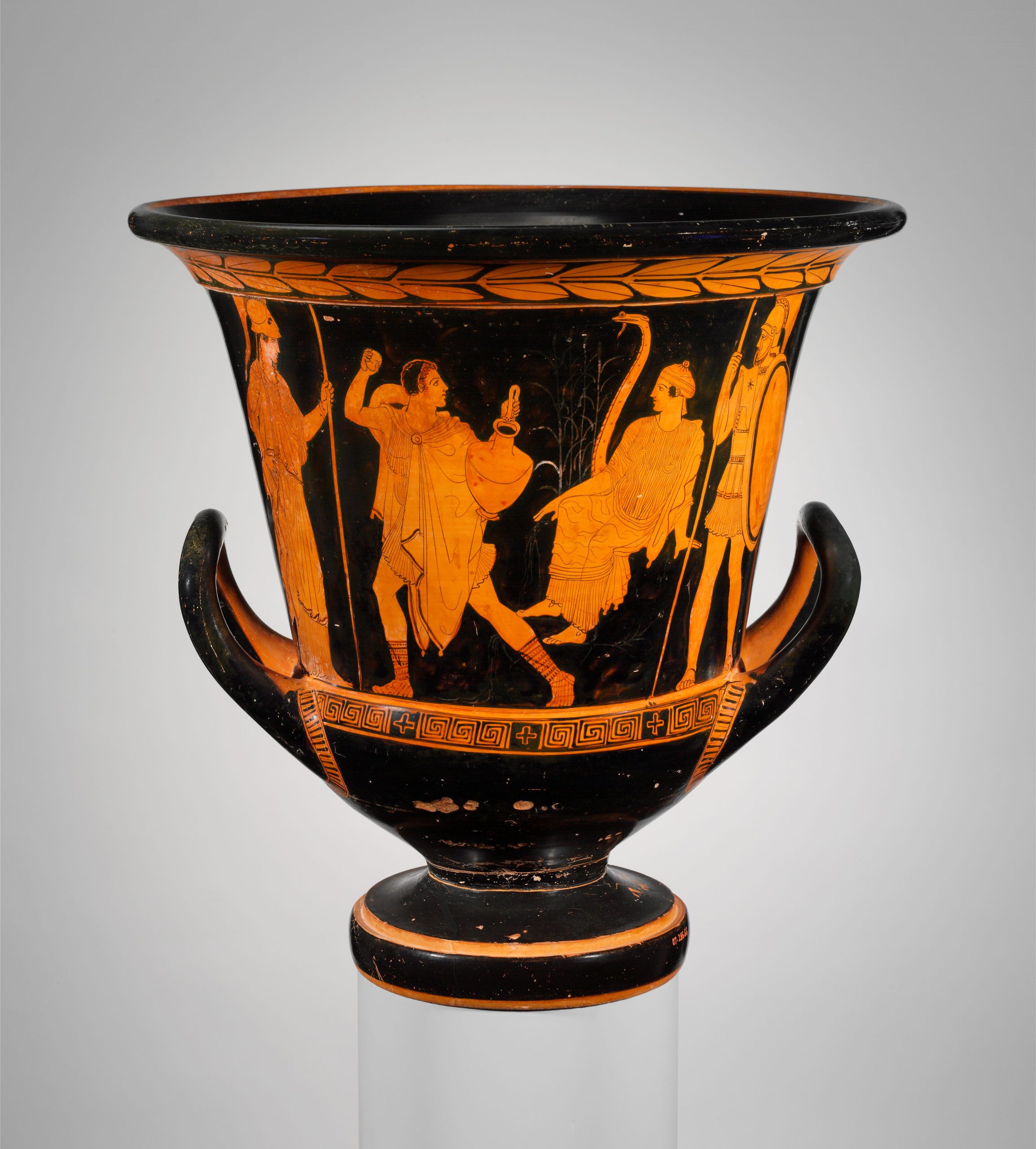
There are four main episodes from the mythology of the Theban Cycle that are very often represented in Greek and Roman art: Cadmus slaying the dragon; Oedipus being interrogated by the Sphinx; the expedition of the seven Argive armies against Thebes; and the death of king Pentheus at the hands of the followers of Dionysus. Another scene, the death of Actaeon mauled by his own dogs, was already discussed in the chapter dedicated to Artemis.
For the first one, the scene usually shows Cadmus fighting a giant snake. As the scene takes place at the Ismenian Spring, the hero is often portrayed holding a water jug alongside his weapons. Athena is usually represented behind Cadmus, as she assisted him in this feat, while Ares, to whom the dragon was sacred, is standing behind the monster.
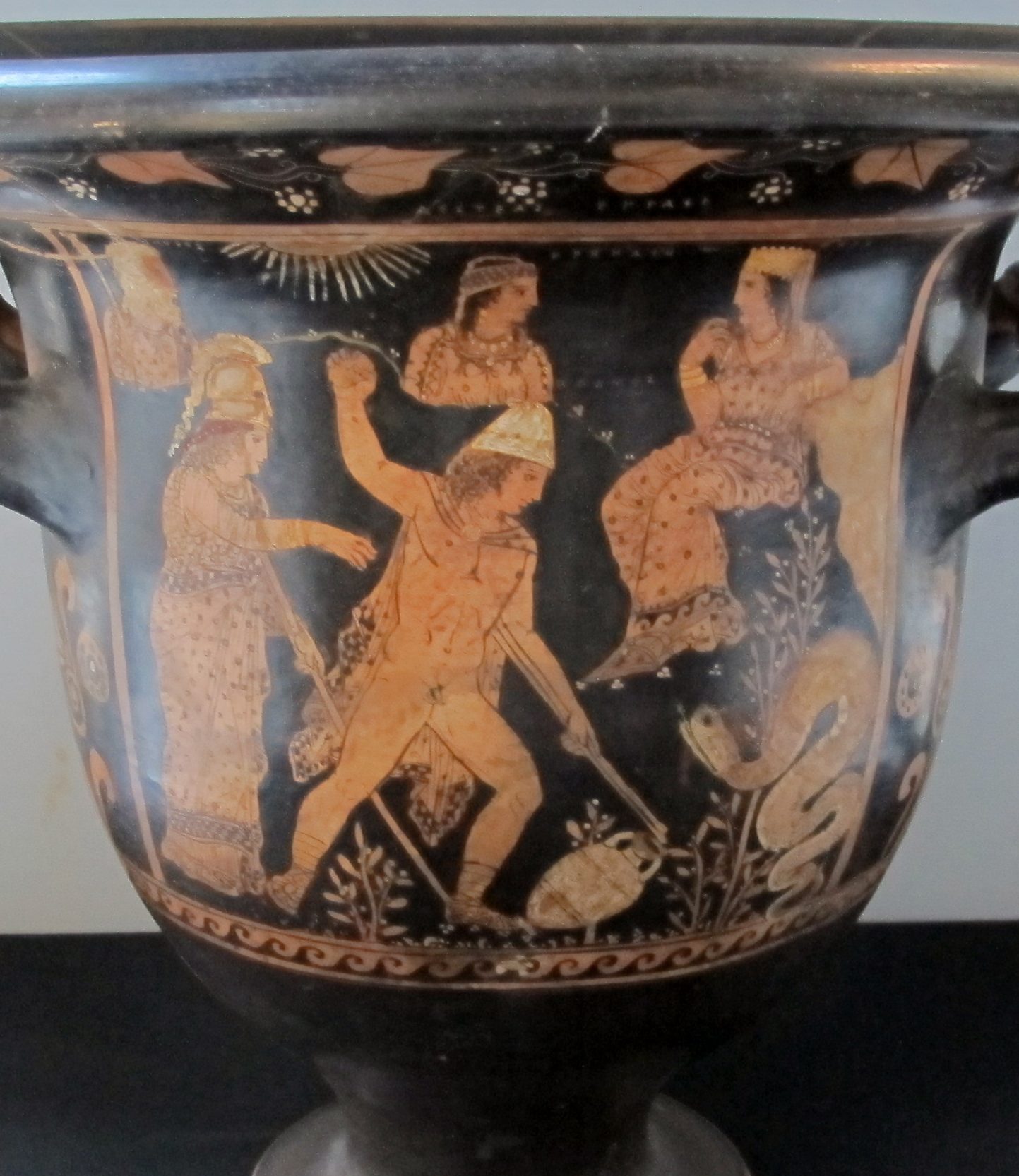


The encounter between Oedipus and the Sphinx was another very popular theme in ancient Greek art. The hero is usually represented wearing the cloak and hat of travelers (as he was indeed on the road) and holding a walking stick, while the monster, a winged lion with a human head, is perching either on a column or a rock.
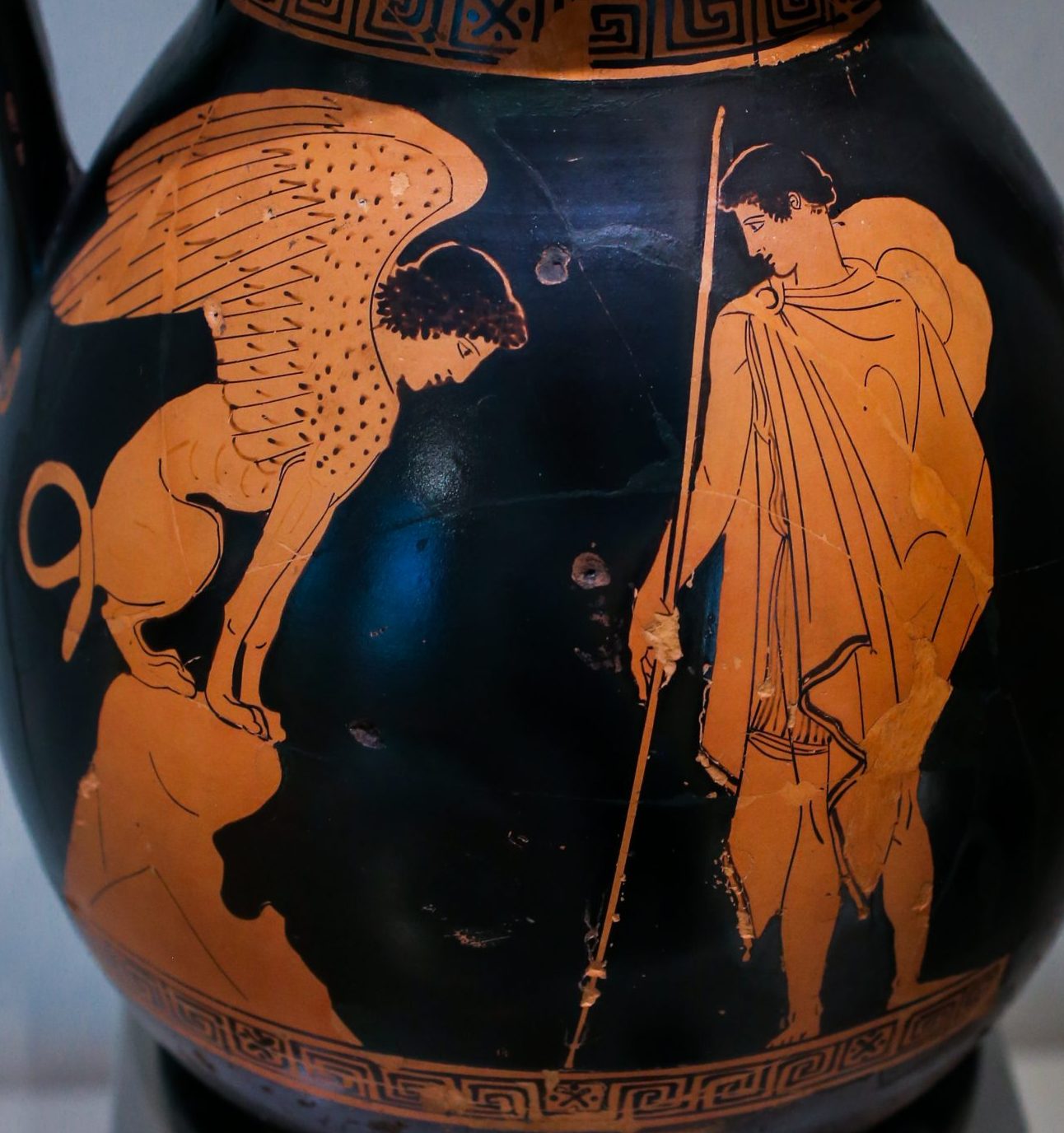
The third myth is usually represented in two ways: either the leaders of the Argive expedition arming themselves, or episodes from the battle at the gates.
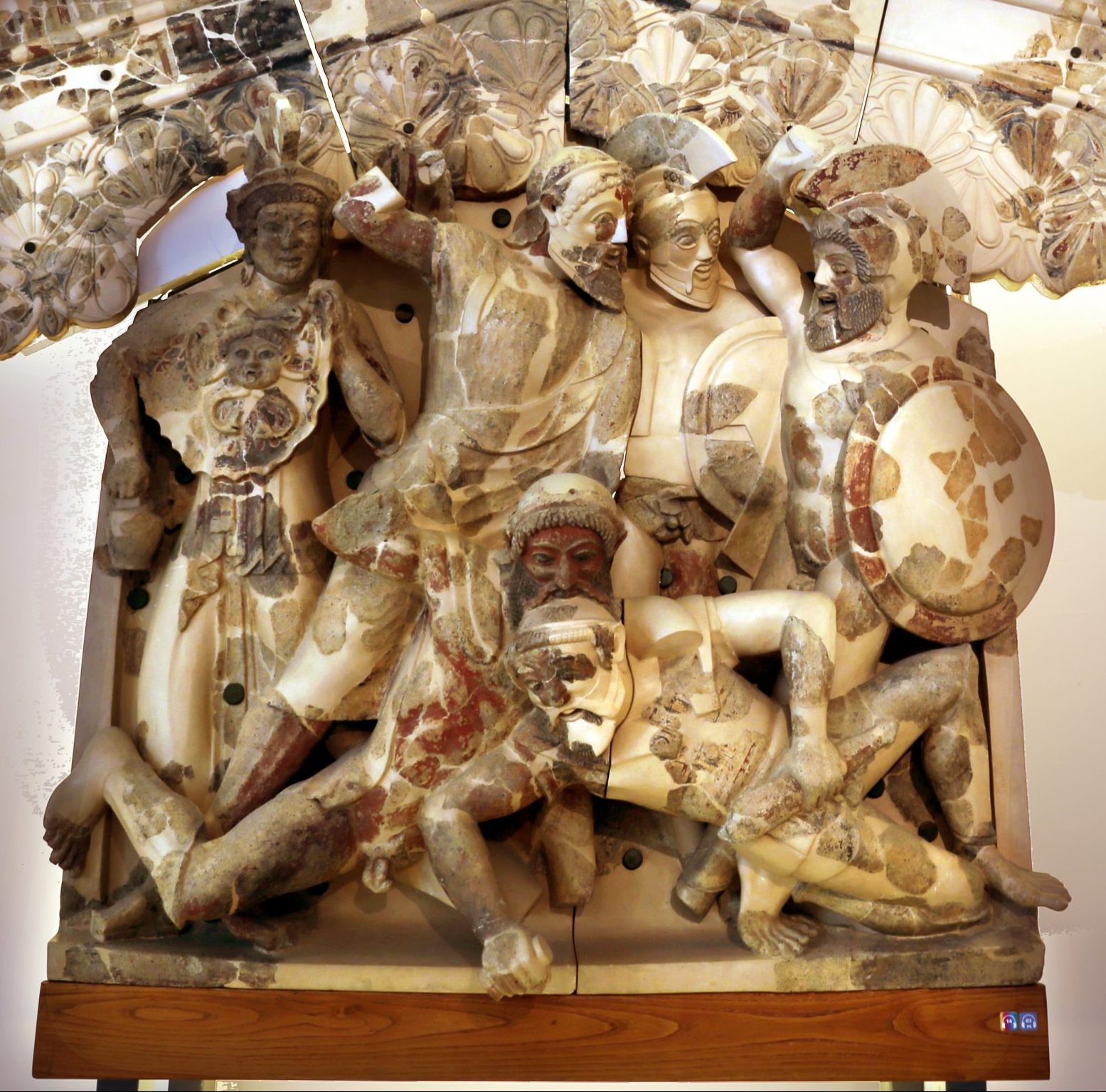
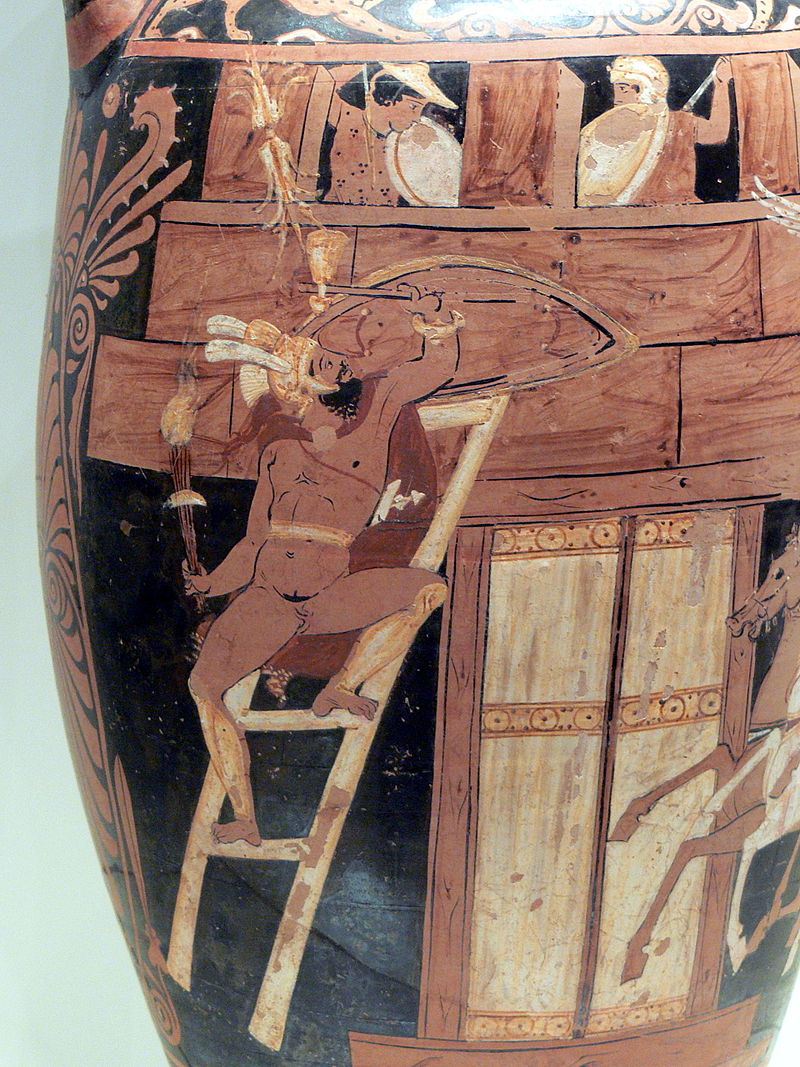
Two popular scenes from the second category are the fall of Capaneus from the walls, and the duel between Eteocles and Polynices. The siege of Thebes became very popular in Etruscan art, so that the expedition of the Seven was represented on at least two temple pediments from the 5th and 2nd century BCE, and the duel between Eteocles and Polynices was a common decorative motif funerary urns during the 3rd and 2nd centuries BCE.

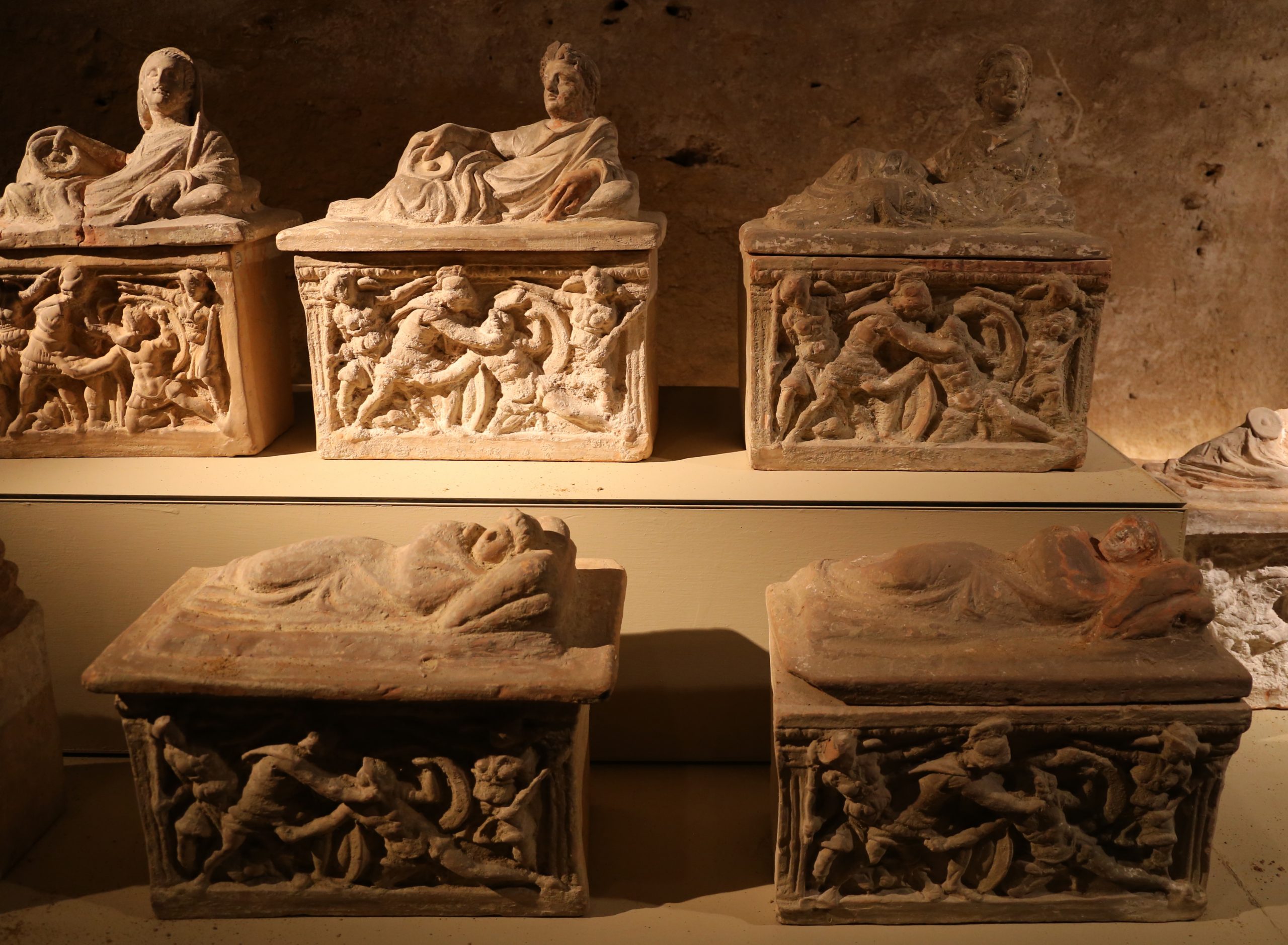
The last mythological episode from the Theban Cycle to be fairly common in art is the death of Pentheus. Greek and Roman artists usually represented the moment of or the moments immediately his ritual dismemberment (sparagmos) at the hands of the followers of Dionysus. The women are generally shown carrying away their macabre trophies, and Agave, Pentheus’ mother, is the one holding his head.
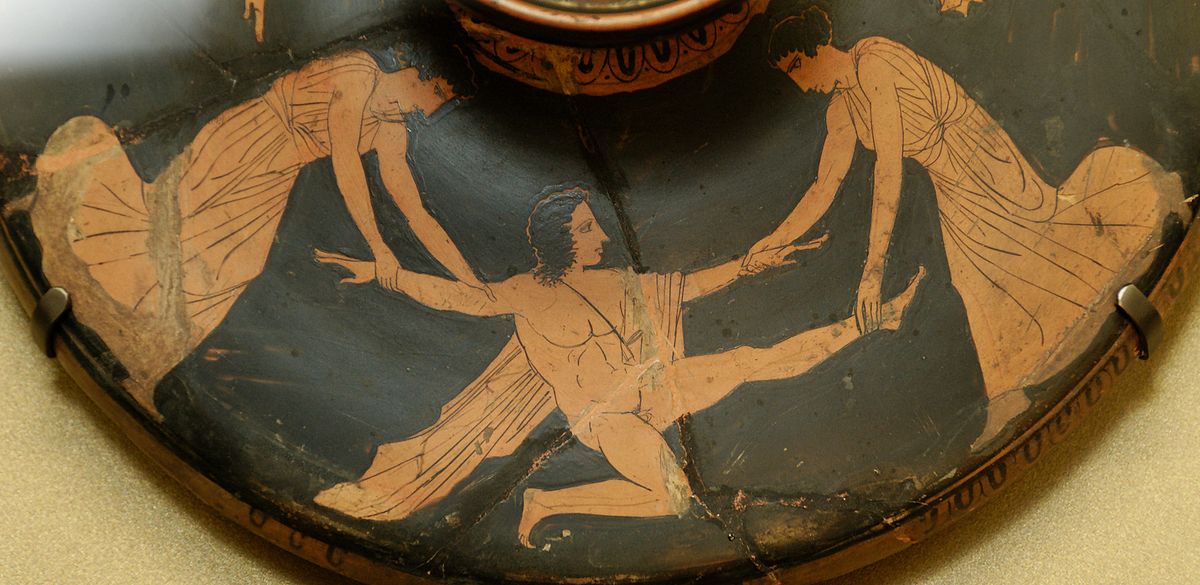
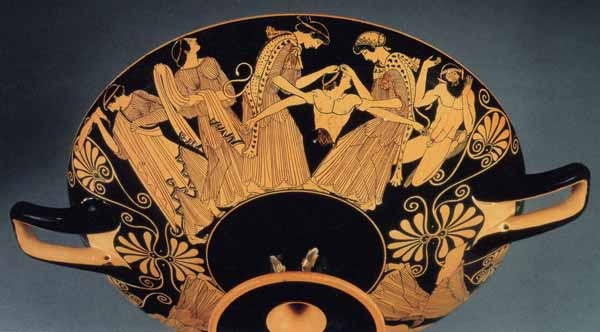
Media Attributions and Footnotes
Media Attributions
- Oedipus being questioned by the Sphinx, Attic red-figured kylix, by the Oedipus Painter, 470-460 BC, inv. 16541 – Museo Gregoriano Etrusco – Vatican Museums © Daderot is licensed under a Public Domain license
- Family Tree of the House of Cadmus © Luoyao Zhang is licensed under a CC BY-SA (Attribution ShareAlike) license
- Terracotta calyx-krater (bowl for mixing wine and water) © the Metropolitan Museum is licensed under a Public Domain license
- Pittore di napoli 2074, cratere a campana con thiasos, da paestum, 380-370 ac ca. © Sailko is licensed under a CC BY-SA (Attribution ShareAlike) license
- Kadmos dragon Louvre N3157 © Bibi Saint-Pol is licensed under a Public Domain license
- Kadmos dragon Louvre E707 © Bibi Saint-Pol is licensed under a Public Domain license
- Achilles Painter ARV 990 49 Oedipus and the Sphinx – man (01) © ArchaiOptix is licensed under a CC BY-SA (Attribution ShareAlike) license
- Altorilievo del frontone posteriore del tempio A di pyrgi, con scene della saga tebana, 470-460 ac. ca., 01 © Sailko is licensed under a CC BY-SA (Attribution ShareAlike) license
- Seven against Thebes Getty Villa 92.AE.86 © Wolfgang Sauber is licensed under a CC BY-SA (Attribution ShareAlike) license
- Luni Pediment Group © Tetraktys is licensed under a CC BY-SA (Attribution ShareAlike) license
- Urnette fittili di produzione chiusina, 210-90 ac ca. 16 combattimento di eteocle e polinice © Sailko is licensed under a CC BY (Attribution) license
- Death Pentheus Louvre G445 © Jastrow is licensed under a Public Domain license
- Raffigurazione di Penteo su un vaso greco- 2014-02-08 01-13 © Ilaria.Manfrini is licensed under a CC BY-SA (Attribution ShareAlike) license
- Pherecydes was a mythology writer from the 6th century BCE. He is quoted by other famous authors such as Aristotle and Plutarch, but his works are lost. ↵
- The practise of "raising a boy as a girl" may be in reference to a custom of dressing boys as girls in order to avert the evil eye. Other figures in Greek mythology, such as Achilles, were also raised in this way (adapted from commentary by J. G. Frazer taken from Theoi.com). For further discussion of the birth and raising of Dionysus, see chapter 15. ↵
- Acusilaus of Argos was a Greek mytholographer and logographer of the late 6th Century BCE. His work only survive in fragments or in summaries by later authors. ↵
- Indicates a gap or missing section of the text. ↵
- See chapter 15. ↵
- See chapter 15. ↵
- The process of "exposure" in ancient Greece was a fairly common method of getting rid of an undesired child (often a female child when a male child was wanted) by abandoning them out in nature. ↵
- For Ovid's account of the myth of Niobe, see chapter 13. ↵
- Oedipus roughly translates to "swollen foot". ↵
- The “narrow road” is the famous Cleft Way (Pausanias. 10.5.3) now called the Crossroad of Megas (Stavrodromi tou Mega), where the road from Daulis and the road from Thebes and Lebadea meet and unite in the single road ascending through the long valley to Delphi. ↵
- Adrastus received an oracle from Apollo telling him to "yoke his daughters to a boar and a lion." According to one interpretation the boar on the shield of Tydeus referred to the Calydonian boar, while the lion on the shield of Polynices referred to the lion-faced [pb_glossary id="4617"]Sphinx[/pb_glossary]. Others preferred to suppose that the two chieftains were clad in the skins of a boar and a lion respectively (adapted from commentary by J. G. Frazer, taken from Theoi.com). ↵
- The list of the Seven Against Thebes varies between sources, and many sources also list a number other than seven. ↵
- "Archemorus" translates to “beginner of doom”; hence “ominous,” “foreboding.” ↵
- See chapter 11. ↵
- A "suppliant" (αἰδώς) in ancient Greece had a more formal definition, such that if someone performed the gestures of supplication towards someone, they would be honour-bound to respect the suppliant's need. The "suppliant's bow" refers to the branch of olive which a suppliant laid on the altar of a god as a token to show that they sought divine protection (adapted from commentary by J. G. Frazer, taken from Theoi.com). ↵
- Compare the myth of Orestes and the Furies in chapter 11 and chapter 30. ↵
- "purification" here refers to the Greek concept of miasma, the idea that death defiles someone or makes them impure. For further explanation, see Mythology Unbound. ↵
Founder and first king of Thebes, husband of Harmonia, and father of Ino, Semele, Agave, and Autonoe.
Featured in chapter 15 and chapter 37.
A Phoenician princess, the first queen of Crete, and mother of Minos. Known for being abducted by Zeus in the form of a bull and taken to Crete.
Featured in chapter 22.
A son of Antiope and Zeus, husband of Niobe, and twin brother of Zethus. Known for being said to have built the walls of Thebes (with his brother).
Featured in chapter 37. Also appears in chapter 13.
1550 – 1050 BCE
A city in the Argolis. Associated with the line of Perseus, Tantalus, and the house of Atreus.
See chapter 39.
Approximately 750 – 479 BCE
479 – 323 BCE
Approximately 323 – 31 BCE
A Phoenician queen, mother of Cadmus and Europa, and wife of either Agenor or Phoenix.
Appears in chapter 22.
Called Delphi or Pytho.
A panhellenic sanctuary sacred to Apollo as the location of the Delphic Oracle.
See chapter 43. Also featured in chapter 12.
Greek: Athena
Roman: Minerva
Goddess of warfare, wisdom, and craft.
See chapter 9.
Greek: Ares
Roman: Mars
God of war.
See chapter 10.
Soldiers grown from dragon teeth planted in the soil. Known for being one of Jason's challenges on his quest for the Golden Fleece, and for appearing in the foundation myth of Thebes.
Featured in chapter 18 and chapter 37.
Greek: Zeus
Roman: Jupiter or Jove
God of the sky, ruler of the Olympian gods.
See chapter 5.
Greek: Harmonia
Roman: Concordia
Personification of harmony. Wife of Cadmus, and mother of Semele, Ino, Autonoe, and Agave.
Featured in chapter 15.
Greek: Aphrodite
Roman: Venus
Goddess of love and passion.
See chapter 4.
Greek: Hephaestus
Roman: Vulcan
God of fire, smiths, and craftspeople.
See chapter 8.
A maenad, daughter of Cadmus and Harmonia, and mother of Actaeon. Known for being a nurse of Dionysus.
Featured chapter 15.
Called Ino (mortal) or Leucothea (after apotheosis).
Daughter of Cadmus, sister of Semele, and mother of Melicertes/Palaemon. Known for being a maenad and a nurse of Dionysus. Upon her death, she was transformed into a sea goddess and worshipped as "Leucothea".
Featured in chapter 15 and chapter 18.
Called Semele (when mortal) or Thyone (after apotheosis).
A princess of Thebes, daughter of Cadmus and Harmonia, and mother of Dionysus. Born a mortal, but made a goddess after her death.
Featured in chapter 15.
A leader of the maenads. Daughter of Cadmus and Harmonia, and mother of Pentheus. Known for being a nurse of Dionysus, and for killing her son.
Featured in chapter 15.
A king of Boeotia. Son of Aeolus, husband of Nephele, Ino, and Themisto, and father of Phrixus and Melicertes. Known for being cursed by Hera as punishment for helping raise Dionysus.
Featured in chapter 15 and chapter 18.
A god of many minor pastoral crafts. Husband of Autonoe and father of Actaeon.
Greek: Hera
Roman: Juno
Goddess of marriage, wife of Zeus.
See chapter 6.
Greek: Dionysus
Roman: Bacchus
God of wine and revelry.
See chapter 15.
Greek: Hermes
Roman: Mercury
God of travelers and trickery.
See chapter 16.
Called Melicertes (before apotheosis) or Palaemon (after apotheosis)
A son of Athamas and Ino. Known for becoming a god after being thrown into the sea by his mother.
Appears in chapter 15 and chapter 18.
Founder of Ephyre (later Corinth) and son of Aeolus of Thessaly. Known for attempting to cheat death (twice), and for being punished in the underworld to push a boulder up a hill forever. In some traditions, father of Odysseus.
Appears in chapter 41.
Minor nature deities.
A mountain or mountainous region associated with the worship of Dionysus. Nysa is located in different locations according to different authors, but is always outside of Greece (often in Africa).
Featured in chapter 15.
A group of nymphs of rain thought to have lived in Nysa. Daughters of Atlas. Known for helping raise Dionysus, and for being immortalized by Zeus as a constellation as a reward.
A hero from Thebes and daughter of Autonoe. Known for being killed by his hunting dogs as punishment from Artemis.
Featured in chapter 13.
A wise centaur, known for training many famous heroes including Jason, Achilles, Theseus, and Perseus.
Appears in chapter 17 and chapter 26.
A mountain sacred to Dionysus. Known for being the site of the deaths of Pentheus and Actaeon.
Featured in chapter 15. Also appears in chapter 13.
Greek: Artemis
Roman: Diana
Maiden goddess of wilderness and the hunt, and twin sister of Apollo.
See chapter 13.
A king of Thebes and son of Agave. Known for being killed by his mother as punishment for refusing to worship Dionysus.
Featured in chapter 15.
Women worshippers of Dionysus, known for acting wildly and in a frenzy.
Featured in chapter 15.
Greek: Hades
Roman: Pluto
God of the underworld. Hades may also refer to the underworld itself, the kingdom of Hades.
See chapter 42.
God of medicine, archery, oracles, and the sun.
See chapter 12.
The blissful paradise part of the Underworld, populated with heroes and good souls.
Appear in chapter 41.
A king of Thebes, brother of Lycus and father (in some accounts) of Antiope.
Appears in chapter 37.
A king of Thebes, husband of Jocasta and father of Oedipus. Known for being killed by Oedipus, according to a prophecy from the Oracle of Delphi.
Featured in chapter 37.
A king of Thebes and husband of Dirce. Known for being killed either by his grandsons, or by Heracles.
Featured in chapter 37. Also appears in chapter 17.
A son of Antiope and Zeus, and twin brother of Amphion. Known for being said to have built the walls of Thebes (with his brother).
Appears in chapter 37.
A daughter of Nycteus or of Asopus, and mother of Amphion and Zethus. Known for fleeing Thebes after becoming pregnant with Zeus' children, and for being persecuted by and involved in the deaths of Lycus and Dirce.
Appears in chapter 37.
A queen of Thebes and wife of Lycus, or a spring near Thebes where Dirce became a nymph after her death. Known for helping raise Heracles and Dionysus.
Featured in chapter 37. Also appears in chapter 15 and chapter 17.
A king of Pisa (though originally from Lydia or Phrygia). A son of Tantalus (in most traditions), husband of Hippodamia, and father of Atreus and Pittheus. Known for his victory in a chariot race at Olympia.
Appears in chapter 39.
A queen of Thebes and daughter of Tantalus. Known for being the mother of 7 sons and 7 daughters, all of whom were killed by Artemis and Apollo as vengeance for an insult to Leto.
Featured in chapter 13.
A son of Zeus, and father of Pelops and Niobe. Known for stealing nectar and ambrosia for the gods, and for attempting to feed his son Pelops to the gods in stew. For this crime, he was punished in the afterlife and his descendants (the house of Atreus) were cursed.
Featured in chapter 5, chapter 39, and chapter 41.
Greek: Leto
Roman: Latona
Titan mother of Artemis and Apollo.
Featured in chapter 12 and chapter 13.
A king of Pylos and brother of Pelias. Sometimes counted among the Argonauts. Known for being killed by Heracles for refusing to settle his blood debt.
Featured in chapter 17 and Homer's Odyssey.
A queen of Thebes, wife of Laius and later (accidentally) of her son Oedipus.
Featured in chapter 37.
A king of Thebes, and son of Jocasta and Laius. Known for accidentally killing his father and marrying his mother Jocasta in fulfilment of an oracle.
Featured in chapter 37.
A king of Thebes, and brother of Jocasta. Known for refusing to bury Polynices, leading to the deaths of his wife, his son Haemon, and his niece Antigone.
Featured in chapter 37.
A creature hybrid of a lion, bird, and woman, and a child of Echidna and Typhon. Known for learning the art of riddles from the Muses, and for her encounter with Oedipus (who solved the Sphinx's riddle).
Appears in chapter 37.
A dracaena, and the mother of many famous monsters including Cerberus, the Hydra, and the Nemean Lion.
Featured in chapter 1.
Nine deities of art, music, poetry, and creativity; daughters of Zeus and Mnemosyne.
A son of Oedipus and Jocasta, brother of Eteocles, and one of the Seven Against Thebes. Known for dying in his duel with his brother Eteocles.
Featured in chapter 37.
A son of Oedipus and Jocasta, and brother of Polynices. Known for defending against the Seven Against Thebes, and for dying in a duel with his brother Polynices.
Featured in chapter 37.
A daughter of Oedipus and Jocasta, and sister of Polynices and Eteocles. Known for defying her uncle Creon by burying Polynices, as told in Sophocles' play Antigone.
Featured in chapter 37.
Called Erinyes, Eumenides, or Furies.
Three goddesses of vengeance and punishment.
Featured in chapter 9 and chapter 41.
A king and founder of Athens. The son of Aegeus and Aethra, husband of Hippolyte and later of Phaedra, and father of Hippolytus. Known for his encounters on the road to Athens, and for killing the Minotaur.
See chapter 22. Also appears in chapter 36 and chapter 41.
A king of Argos, known for leading the Seven Against Thebes.
One of the Seven Against Thebes, father of Diomedes of Argos and son of Oeneus.
A king of Calydon, husband of Althaea, and father of Deianira and Meleager. Known for neglecting to sacrifice to Artemis, prompting her to send the Calydonian Boar to terrorize the land.
Featured in chapter 24.
A seer of Argos and Argonaut, and husband of Eriphyle. Known for being killed by Zeus, for participating in the Calydonian Boar Hunt, and for leading the Seven Against Thebes. Worshipped as a god in some traditions.
Appears in chapter 18, chapter 21, and chapter 24.
Wife of Amphiaraus, known for convincing Amphiaraus to join the Seven Against Thebes despite knowing that he would die.
One of the Seven Against Thebes, known for being killed by Zeus as punishment for boasting.
A son of Atalanta, and one of the Seven Against Thebes.
Called Hippomenes or Melanion.
A hero of Arcadia and husband of Atalanta. Known for "winning" Atalanta in a footrace with the help of Aphrodite.
Featured in chapter 24.
A king of Nemea or a priest of Zeus in Nemea. Known for originating the Nemean Games after the death of his son, and for his encounter with the army of the Seven Against Thebes.
Appears in chapter 37.
A queen of Lemnos. Known for saving her father (while all the other women of Lemnos killed their male relatives), and for her encounter with the Argonauts.
Appears in chapter 18.
Wife of Orpheus, known for being killed by a snake bite, and for then prompting Orpheus' journey to the Underworld.
Featured in chapter 41.
A term to describe all the Greeks and people of Greek origin, notably the Greek armies in Homer's Iliad.
A seer and priest of Apollo from Thebes, and son of Chariclo. Lives for many generations, and known for his roles in many myths.
Featured in chapter 15. Also appears in chapter 9, chapter 17, chapter 30, and chapter 41.
A nymph, worshipper of Athena, and mother of Teiresias.
Featured in chapter 9.
A hero of Pylos and Argonaut, and son of Neleus. Known for his ability to shapeshift, and for being killed by Heracles.
Greek: Poseidon
Roman: Neptune
God of the sea.
See chapter 7.
Greek: Demeter
Roman: Ceres
Goddess of agriculture.
See chapter 10.
A city in the region of Attica. Associated with Athena, Theseus, and Cecrops. Site of the Acropolis, Parthenon, and Agora.
See chapter 36.
Wife of Capaneus. Known for throwing herself onto her husbands funeral pyre after he was killed in the battle of the Seven Against Thebes.
Appears in chapter 37 and chapter 41.
Collective term for the sons of the Seven Against Thebes. Known for attempting to avenge their fathers.
Featured in chapter 37.
The leader of the Epigoni, and son of Eriphyle and Amphiaraus. Known for killing his mother Eriphyle, and for being killed in a conflict over the robe and necklace of Harmonia.
Featured in chapter 37.
A king of Argos, known for fighting in the Trojan War as a favoured warrior of Athena. Deified upon his death.
Featured in chapter 27.
A large river in Greece, or the god personifying this river. Known for fighting Heracles for the marriage of Deianira.
Featured in chapter 17.
A king of Corinth and father of Creusa/Glauce.
Featured in chapter 19.

